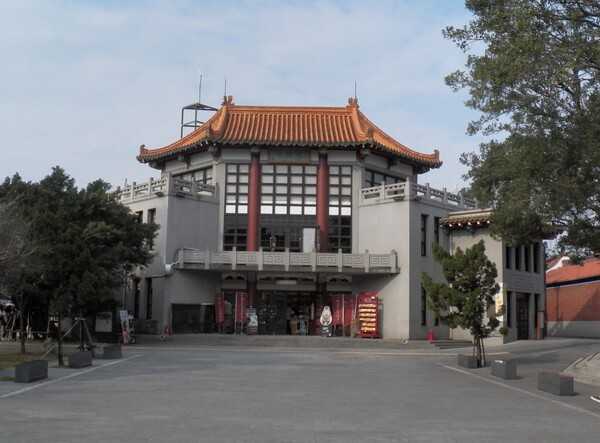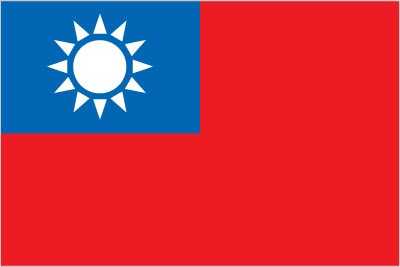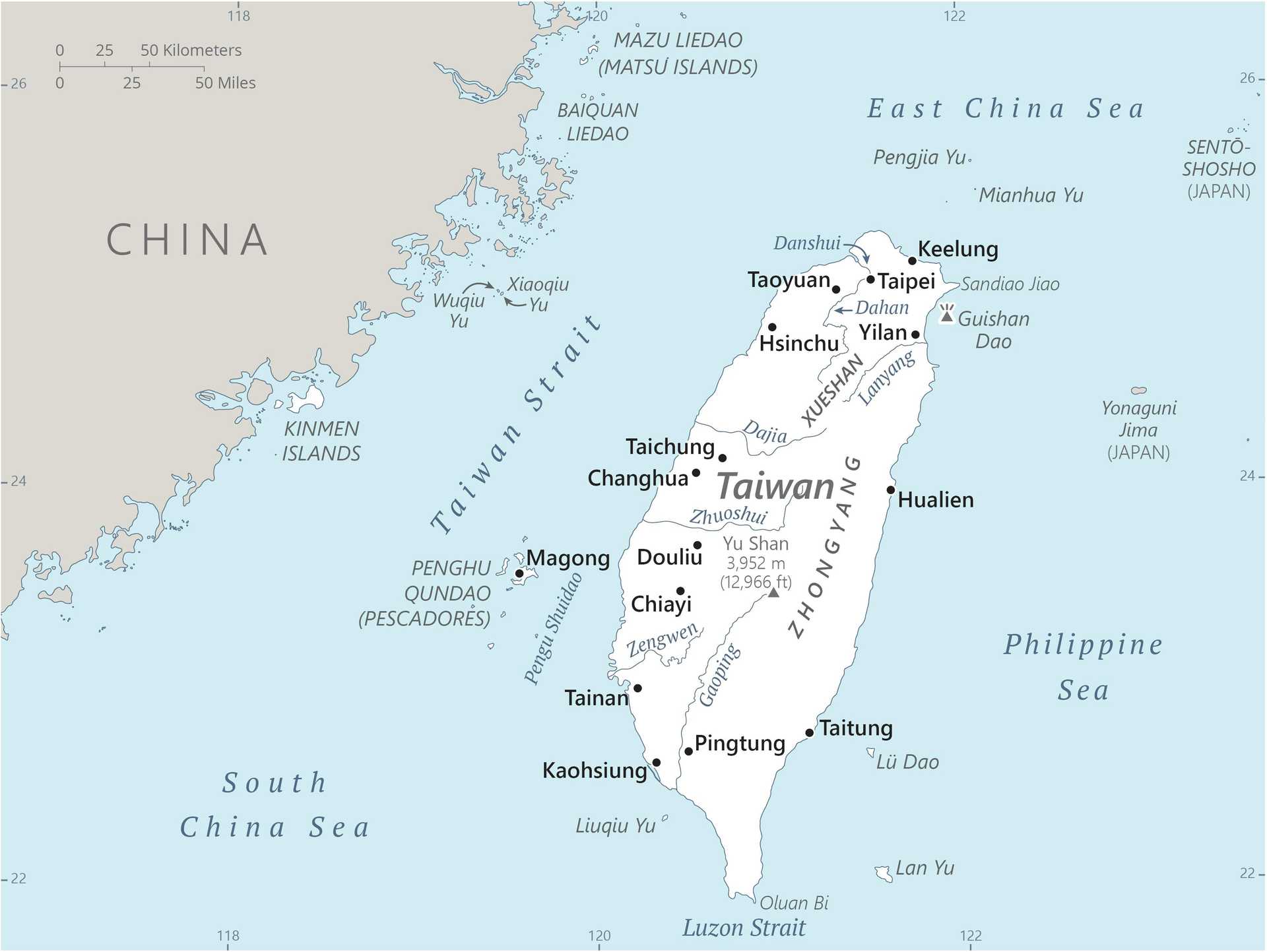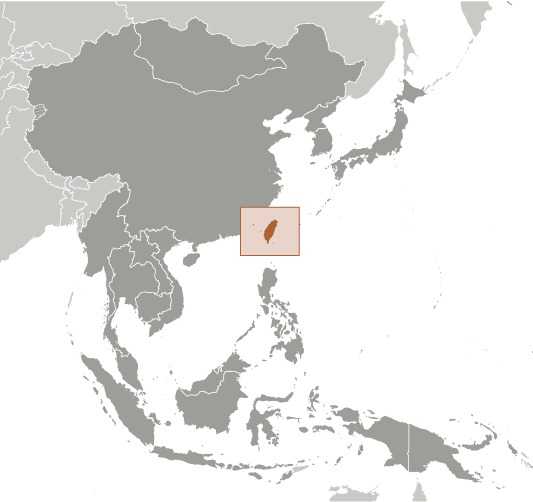Introduction
Background
First inhabited by Austronesian people, Taiwan became home to Han immigrants beginning in the late Ming Dynasty (17th century). In 1895, military defeat forced China's Qing Dynasty to cede Taiwan to Japan, which then governed Taiwan for 50 years. Taiwan came under Chinese Nationalist (Kuomintang, KMT) control after World War II. With the communist victory in the Chinese civil war in 1949, the Nationalist-controlled Republic of China government and 2 million Nationalists fled to Taiwan and continued to claim to be the legitimate government for mainland China and Taiwan, based on a 1947 constitution drawn up for all of China. Until 1987, however, the Nationalist Government ruled Taiwan under a civil war martial law declaration dating to 1948. Beginning in the 1970s, Nationalist authorities gradually began to incorporate the native population into the governing structure beyond the local level.
The democratization process expanded rapidly in the 1980s, leading to the then-illegal founding of the Democratic Progressive Party (DPP), Taiwan’s first opposition party, in 1986 and the lifting of martial law the following year. Taiwan held legislative elections in 1992, the first in over 40 years, and its first direct presidential election in 1996. In the 2000 presidential elections, Taiwan underwent its first peaceful transfer of power with the KMT loss to the DPP and afterwards experienced two additional democratic transfers of power in 2008 and 2016. Throughout this period, the island prospered and turned into one of East Asia's economic "Tigers," becoming a major investor in mainland China after 2000 as cross-Strait ties matured. The dominant political issues continue to be economic reform and growth, as well as management of sensitive relations between Taiwan and China.
Visit the Definitions and Notes page to view a description of each topic.
Geography
Location
Eastern Asia, islands bordering the East China Sea, Philippine Sea, South China Sea, and Taiwan Strait, north of the Philippines, off the southeastern coast of China
Geographic coordinates
23 30 N, 121 00 E
Map references
Southeast Asia
Area
total : 35,980 sq km
land: 32,260 sq km
water: 3,720 sq km
note: includes the Pescadores, Matsu, and Kinmen islands
comparison ranking: total 138
Area - comparative
slightly smaller than Maryland and Delaware combined
Land boundaries
total: 0 km
Coastline
1,566.3 km
Maritime claims
territorial sea: 12 nm
exclusive economic zone: 200 nm
Climate
tropical; marine; rainy season during southwest monsoon (June to August); persistent and extensive cloudiness all year
Terrain
eastern two-thirds mostly rugged mountains; flat to gently rolling plains in west
Elevation
highest point: Yu Shan 3,952 m
lowest point: South China Sea 0 m
mean elevation: 1,150 m
Natural resources
small deposits of coal, natural gas, limestone, marble, asbestos, arable land
Land use
agricultural land: 22.7% (2018 est.)
arable land: 16.9% (2018 est.)
permanent crops: 5.8% (2018 est.)
other: 77.3% (2018 est.)
Irrigated land
3,820 sq km (2012)
Population distribution
distribution exhibits a peripheral coastal settlement pattern, with the largest populations on the north and west coasts
Natural hazards
earthquakes; typhoons
volcanism: Kueishantao Island (401 m), east of Taiwan, is its only historically active volcano, although it has not erupted in centuries
Geography - note
strategic location adjacent to both the Taiwan Strait and the Luzon Strait
People and Society
Population
total: 23,595,274
male: 11,606,491
female: 11,988,783 (2024 est.)
comparison rankings: female 57; male 58; total 58
Nationality
noun: Taiwan (singular and plural)
adjective: Taiwan (or Taiwanese)
note: example - he or she is from Taiwan; they are from Taiwan
Ethnic groups
Han Chinese (including Holo, who compose approximately 70% of Taiwan's population, Hakka, and other groups originating in mainland China) more than 95%, indigenous Malayo-Polynesian peoples 2.3%
note 1: there are 16 officially recognized indigenous groups: Amis, Atayal, Bunun, Hla'alua, Kanakaravu, Kavalan, Paiwan, Puyuma, Rukai, Saisiyat, Sakizaya, Seediq, Thao, Truku, Tsou, and Yami; Amis, Paiwan, and Atayal are the largest and account for roughly 70% of the indigenous population
note 2: although not definitive, the majority of current genetic, archeological, and linguistic data support the theory that Taiwan is the ultimate source for the spread of humans across the Pacific to Polynesia; the expansion (ca. 3000 B.C. to A.D. 1200) took place via the Philippines and eastern Indonesia and reached Fiji and Tonga by about 900 B.C.; from there voyagers spread across the rest of the Pacific islands over the next two millennia
Languages
Mandarin (official), Min Nan, Hakka dialects, approximately 16 indigenous languages
major-language sample(s):
世界概況 – 不可缺少的基本消息來源 (Mandarin)
The World Factbook, the indispensable source for basic information.
Religions
Buddhist 35.3%, Taoist 33.2%, Christian 3.9%, folk religion (includes Confucian) approximately 10%, none or unspecified 18.2% (2005 est.)
Age structure
0-14 years: 12.1% (male 1,472,059/female 1,391,031)
15-64 years: 69% (male 8,132,356/female 8,155,582)
65 years and over: 18.8% (2024 est.) (male 2,002,076/female 2,442,170)
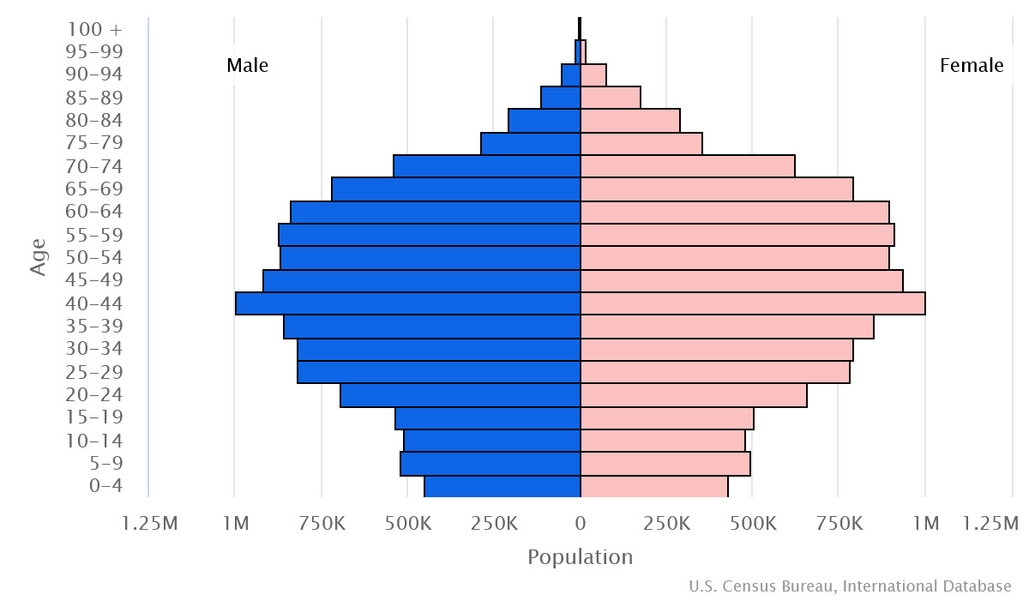
Dependency ratios
total dependency ratio: 40.2
youth dependency ratio: 17.8
elderly dependency ratio: 22.4
potential support ratio: 4.5 (2021 est.)
Median age
total: 44.6 years (2024 est.)
male: 43.6 years
female: 45.5 years
comparison ranking: total 29
Population distribution
distribution exhibits a peripheral coastal settlement pattern, with the largest populations on the north and west coasts
Urbanization
urban population: 80.1% of total population (2023)
rate of urbanization: 0.65% annual rate of change (2020-25 est.)
Major urban areas - population
4.504 million New Taipei City, 2.754 million TAIPEI (capital), 2.319 million Taoyuan, 1.553 million Kaohsiung, 1.369 million Taichung, 863,000 Tainan (2023)
Sex ratio
at birth: 1.06 male(s)/female
0-14 years: 1.06 male(s)/female
15-64 years: 1 male(s)/female
65 years and over: 0.82 male(s)/female
total population: 0.97 male(s)/female (2024 est.)
Infant mortality rate
total: 3.8 deaths/1,000 live births (2024 est.)
male: 4.2 deaths/1,000 live births
female: 3.5 deaths/1,000 live births
comparison ranking: total 191
Life expectancy at birth
total population: 81.6 years (2024 est.)
male: 78.6 years
female: 84.7 years
comparison ranking: total population 43
Gross reproduction rate
0.54 (2024 est.)
Contraceptive prevalence rate
75.2% (2016)
note: percent of women aged 20-52
Drinking water source
improved: urban: NA
rural: NA
total: NA
unimproved: urban: NA
rural: NA
total: NA
Sanitation facility access
improved: urban: NA
rural: NA
total: NA
unimproved: urban: NA
rural: NA
total: NA
Currently married women (ages 15-49)
51% (2023 est.)
Literacy
definition: age 15 and over can read and write
total population: 98.5%
male: 99.7%
female: 97.3% (2014)
Environment
Environment - current issues
air pollution; water pollution from industrial emissions, raw sewage; contamination of drinking water supplies; trade in endangered species; low-level radioactive waste disposal
Climate
tropical; marine; rainy season during southwest monsoon (June to August); persistent and extensive cloudiness all year
Land use
agricultural land: 22.7% (2018 est.)
arable land: 16.9% (2018 est.)
permanent crops: 5.8% (2018 est.)
other: 77.3% (2018 est.)
Urbanization
urban population: 80.1% of total population (2023)
rate of urbanization: 0.65% annual rate of change (2020-25 est.)
Waste and recycling
municipal solid waste generated annually: 7.336 million tons (2015 est.)
Total renewable water resources
67 cubic meters (2011)
Government
Country name
conventional long form: none
conventional short form: Taiwan
local long form: none
local short form: Taiwan
former: Formosa
etymology: "Tayowan" was the name of the coastal sandbank where the Dutch erected their colonial headquarters on the island in the 17th century; the former name "Formosa" means "beautiful" in Portuguese
Government type
semi-presidential republic
Capital
name: Taipei
geographic coordinates: 25 02 N, 121 31 E
time difference: UTC+8 (13 hours ahead of Washington, DC, during Standard Time)
etymology: the Chinese meaning is "Northern Taiwan," reflecting the city's position in the far north of the island
Administrative divisions
includes main island of Taiwan plus smaller islands nearby and off coast of China's Fujian Province; Taiwan is divided into 13 counties (xian, singular and plural), 3 cities (shi, singular and plural), and 6 special municipalities directly under the jurisdiction of the Executive Yuan
counties: Changhua, Chiayi, Hsinchu, Hualien, Kinmen, Lienchiang, Miaoli, Nantou, Penghu, Pingtung, Taitung, Yilan, Yunlin
cities: Chiayi, Hsinchu, Keelung
special municipalities: Kaohsiung (city), New Taipei (city), Taichung (city), Tainan (city), Taipei (city), Taoyuan (city)
note: Taiwan uses a variety of romanization systems; while a modified Wade-Giles system still dominates, the city of Taipei has adopted a Pinyin romanization for street and place names within its boundaries; other local authorities use different romanization systems
National holiday
Republic Day (National Day), 10 October (1911); note - celebrates the anniversary of the Chinese Revolution, also known as Double Ten (10-10) Day
Constitution
history: previous 1912, 1931; latest adopted 25 December 1946, promulgated 1 January 1947, effective 25 December 1947
amendments: proposed by at least one fourth of the Legislative Yuan membership; passage requires approval by at least three-fourths majority vote of at least three fourths of the Legislative Yuan membership and approval in a referendum by more than half of eligible voters; revised several times, last in 2005
Legal system
civil law system
International law organization participation
has not submitted an ICJ jurisdiction declaration; non-party state to the ICCt
Citizenship
citizenship by birth: no
citizenship by descent only: at least one parent must be a citizen of Taiwan
dual citizenship recognized: yes, except that citizens of Taiwan are not recognized as dual citizens of the People's Republic of China
residency requirement for naturalization: 5 years
Suffrage
20 years of age; universal; note - in March 2022, the Legislative Yuan approved lowering the voting age to 18, but the change will require a constitutional amendment that must be submitted to a referendum
Executive branch
chief of state: President LAI Ching-te (since 19 May 2024)
head of government: Premier CHO Jung-tai (President of the Executive Yuan) (since 20 May 2024)
cabinet: Executive Yuan - ministers appointed by president on recommendation of premier
elections/appointments: president and vice president directly elected on the same ballot by simple majority popular vote for a 4-year term (eligible for a second term); election last held on 13 January 2024 (next to be held in 2028); premier appointed by the president; vice premiers appointed by the president on the recommendation of the premier
election results:
2023: LAI Ching-te elected president; percent of vote - LAI Ching-te (DPP) 40.1%, HOU Yu-ih (KMT) 33.5%, KO Wen-je (TPP) 26.5%; note - LAI takes office on 20 May 2024
2020: TSAI Ing-wen reelected president; percent of vote - TSAI Ing-wen (DPP) 57.1%, HAN Kuo-yu (KMT) 38.6%, James SOONG (PFP) 4.3%; note - TSAI is the first woman elected president of Taiwan
Legislative branch
description: unicameral Legislative Yuan (113 seats; 73 members directly elected in single-seat constituencies by simple majority vote, 34 directly elected in a single island-wide constituency by proportional representation vote, and 6 directly elected in multi-seat aboriginal constituencies by proportional representation vote; members serve 4-year terms)
elections: last held on 13 January 2024 (next to be held in 2028)
election results: percent of vote by party - DPP 40.6%, KMT 37.2%, TPP 12.6%, other 5.7%, independent 3.9%; seats by party - KMT 52, DPP 51, TPP 8, independent 2; composition - men 66, women 47, percentage women 41.6%
Judicial branch
highest court(s): Supreme Court (consists of the court president, vice president, and approximately 100 judges organized into civil and criminal panels, each with a chief justice and 4 associate justices); Constitutional Court (consists of the court president, vice president, and 13 justices)
judge selection and term of office: Supreme Court justices appointed by the president; Constitutional Court justices appointed by the president, with approval of the Legislative Yuan; Supreme Court justices serve for life; Constitutional Court justices appointed for 8-year terms, with half the membership renewed every 4 years
subordinate courts: high courts; district courts; hierarchy of administrative courts
Political parties and leaders
Democratic Progressive Party or DPP [LAI Ching-te]
Kuomintang or KMT (Nationalist Party) [Eric CHU Li-luan]
Taiwan People's Party or TPP [KO Wen-je]
note: the DPP and the KMT are the two major political parties; more than 30 parties garnered votes in the 2024 election
International organization participation
ADB (Chinese Taipei), APEC (Chinese Taipei), BCIE, CABEI, IOC, ITUC (NGOs), SICA (observer), WTO (Chinese Taipei)
note - separate customs territory of Taiwan, Penghu, Kinmen, and Matsu
Diplomatic representation in the US
chief of mission: none; commercial and cultural relations with its citizens in the US are maintained through an unofficial instrumentality, the Taipei Economic and Cultural Representative Office in the United States (TECRO), a private nonprofit corporation that performs citizen and consular services similar to those at diplomatic posts, represented by Ambassador Alexander YUI (since 11 December 2023); office: 4201 Wisconsin Avenue NW, Washington, DC 20016; telephone: [1] (202) 895-1800; fax: [1] (202) 363-0999
Taipei Economic and Cultural Offices (branch offices): Atlanta, Boston, Chicago, Denver (CO), Hagatna (Guam), Honolulu, Houston, Los Angeles, Miami, New York, San Francisco, Seattle
Diplomatic representation from the US
chief of mission: the US does not have an embassy in Taiwan; commercial and cultural relations with the people of Taiwan are maintained through an unofficial instrumentality, the American Institute in Taiwan (AIT), a private nonprofit corporation that performs citizen and consular services similar to those at diplomatic posts; it is managed by Director Sandra OUDKIRK (since July 2021)
mailing address: 4170 AIT Taipei Place, Washington DC 20521-4170
telephone: [886] 2-2162-2000
FAX: [886] 2-2162-2251
email address and website: TaipeiACS@state.gov
https://www.ait.org.tw/
branch office(s): American Institute in Taiwan
No. 100, Jinhu Road,
Neihu District 11461, Taipei City
other offices: Kaohsiung (Branch Office)
Flag description
red field with a dark blue rectangle in the upper hoist-side corner bearing a white sun with 12 triangular rays; the blue and white design of the canton (symbolizing the sun of progress) dates to 1895; it was later adopted as the flag of the Kuomintang Party; blue signifies liberty, justice, and democracy, red stands for fraternity, sacrifice, and nationalism, and white represents equality, frankness, and the people's livelihood; the 12 rays of the sun are those of the months and the twelve traditional Chinese hours (each ray equals two hours)
note: similar to the flag of Samoa
National symbol(s)
white, 12-rayed sun on blue field; national colors: blue, white, red
National anthem
name: "Zhonghua Minguo guoge" (National Anthem of the Republic of China)
lyrics/music: HU Han-min, TAI Chi-t'ao, and LIAO Chung-k'ai/CHENG Mao-yun
note: adopted 1930; also the song of the Kuomintang Party; it is informally known as "San Min Chu I" or "San Min Zhu Yi" (Three Principles of the People); because of political pressure from China, "Guo Qi Ge" (National Banner Song) is used at international events rather than the official anthem of Taiwan; the "National Banner Song" has gained popularity in Taiwan and is commonly used during flag raisings
Economy
Economic overview
high-income East Asian economy; most technologically advanced computer microchip manufacturing; increasing Chinese interference threatens market capabilities; minimum wages rising; longstanding regional socioeconomic inequality
Real GDP (purchasing power parity)
$1.143 trillion (2019 est.)
$1.113 trillion (2018 est.)
$1.083 trillion (2017 est.)
note: data are in 2010 dollars
comparison ranking: 30
Real GDP per capita
$47,800 (2019 est.)
$46,600 (2018 est.)
$45,400 (2017 est.)
note: data are in 2017 dollars
comparison ranking: 48
GDP (official exchange rate)
$611.391 billion (2019 est.)
Inflation rate (consumer prices)
0.5% (2019 est.)
1.3% (2018 est.)
0.6% (2017 est.)
comparison ranking: 12
Credit ratings
Fitch rating: AA- (2016)
Moody's rating: Aa3 (1994)
Standard & Poors rating: AA- (2002)
note: The year refers to the year in which the current credit rating was first obtained.
GDP - composition, by sector of origin
agriculture: 1.8% (2017 est.)
industry: 36% (2017 est.)
services: 62.1% (2017 est.)
comparison rankings: services 106; industry 43; agriculture 182
GDP - composition, by end use
household consumption: 53% (2017 est.)
government consumption: 14.1% (2017 est.)
investment in fixed capital: 20.5% (2017 est.)
investment in inventories: -0.2% (2017 est.)
exports of goods and services: 65.2% (2017 est.)
imports of goods and services: -52.6% (2017 est.)
Agricultural products
rice, vegetables, pork, chicken, cabbages, sugarcane, milk, eggs, tropical fruits, pineapples (2022)
note: top ten agricultural products based on tonnage
Industries
electronics, communications and information technology products, petroleum refining, chemicals, textiles, iron and steel, machinery, cement, food processing, vehicles, consumer products, pharmaceuticals
Population below poverty line
1.5% (2012 est.)
Average household expenditures
on food: 13.3% of household expenditures (2021 est.)
on alcohol and tobacco: 2.5% of household expenditures (2021 est.)
Household income or consumption by percentage share
lowest 10%: 6.4%
highest 10%: 40.3% (2010)
Budget
revenues: $94.943 billion (2019 est.)
expenditures: $105.833 billion (2019 est.)
Public debt
35.7% of GDP (2017 est.)
36.2% of GDP (2016 est.)
note: data for central government
comparison ranking: 149
Exports
$388.49 billion (2019 est.)
$383.484 billion (2018 est.)
$382.736 billion (2017 est.)
comparison ranking: 23
Exports - partners
China 22%, US 15%, Hong Kong 12%, Singapore 7%, Japan 6% (2022)
note: top five export partners based on percentage share of exports
Exports - commodities
integrated circuits, machine parts, computers, refined petroleum, plastics (2022)
note: top five export commodities based on value in dollars
Imports
$308.744 billion (2019 est.)
$305.428 billion (2018 est.)
$303.067 billion (2017 est.)
comparison ranking: 26
Imports - partners
China 19%, Japan 12%, US 10%, South Korea 7%, Australia 6% (2022)
note: top five import partners based on percentage share of imports
Imports - commodities
integrated circuits, crude petroleum, machinery, natural gas, coal (2022)
note: top five import commodities based on value in dollars
Reserves of foreign exchange and gold
$456.7 billion (31 December 2017 est.)
$439 billion (31 December 2016 est.)
comparison ranking: 8
Exchange rates
New Taiwan dollars (TWD) per US dollar -
Exchange rates:
28.211 (2020 est.)
30.472 (2019 est.)
30.8395 (2018 est.)
31.911 (2014 est.)
30.363 (2013 est.)
Energy
Electricity
installed generating capacity: 61.944 million kW (2022 est.)
consumption: 274.029 billion kWh (2022 est.)
transmission/distribution losses: 9.615 billion kWh (2022 est.)
comparison rankings: transmission/distribution losses 177; consumption 18; installed generating capacity 22
Electricity generation sources
fossil fuels: 83.7% of total installed capacity (2022 est.)
nuclear: 8.1% of total installed capacity (2022 est.)
solar: 3.8% of total installed capacity (2022 est.)
wind: 1.2% of total installed capacity (2022 est.)
hydroelectricity: 1.8% of total installed capacity (2022 est.)
biomass and waste: 1.3% of total installed capacity (2022 est.)
Nuclear energy
Number of operational nuclear reactors: 2 (2023)
Number of nuclear reactors under construction: 0
Net capacity of operational nuclear reactors: 1.87GW (2023)
Percent of total electricity production: 11% (2021)
Number of nuclear reactors permanently shut down: 2
Coal
production: 5.608 million metric tons (2022 est.)
consumption: 66.855 million metric tons (2022 est.)
exports: 52,000 metric tons (2022 est.)
imports: 63.855 million metric tons (2022 est.)
proven reserves: 1 million metric tons (2022 est.)
Petroleum
total petroleum production: 800 bbl/day (2023 est.)
refined petroleum consumption: 1.022 million bbl/day (2022 est.)
crude oil estimated reserves: 2.38 million barrels (2021 est.)
Natural gas
production: 63.747 million cubic meters (2022 est.)
consumption: 27.157 billion cubic meters (2022 est.)
imports: 27.085 billion cubic meters (2022 est.)
proven reserves: 6.23 billion cubic meters (2021 est.)
Carbon dioxide emissions
306.035 million metric tonnes of CO2 (2022 est.)
from coal and metallurgical coke: 143.069 million metric tonnes of CO2 (2022 est.)
from petroleum and other liquids: 106.739 million metric tonnes of CO2 (2022 est.)
from consumed natural gas: 56.227 million metric tonnes of CO2 (2022 est.)
comparison ranking: total emissions 21
Communications
Telephones - fixed lines
total subscriptions: 10 million (2023 est.)
subscriptions per 100 inhabitants: 43 (2023 est.)
comparison ranking: total subscriptions 18
Telephones - mobile cellular
total subscriptions: 30 million (2023 est.)
subscriptions per 100 inhabitants: 128 (2023 est.)
comparison ranking: total subscriptions 48
Telecommunication systems
general assessment: Taiwan has a highly developed telecoms sector in both the fixed-line and mobile segments; in part this is due to its early moves to liberalize the market, allowing vigorous competition to flourish; the Taiwan authorities have also made concerted efforts to take advantage of Taiwan’s strengths in the development of high-tech, export-oriented industries to encourage and enable the rapid adoption of advanced telecom platforms, while simultaneously leveraging the same telecoms infrastructure to push even further ahead with Taiwan's industrial development plans; Taiwan has one of the highest teledensities in the region; while fixed-line subscriber numbers are trending downwards, the rate of decline has been slowed by the major fixed-line provider investing strongly in building out a widespread fiber network to allow customers to maintain a terrestrial voice connection as part of a fixed broadband package; fiber is the dominant platform in Taiwan’s fixed broadband market; cable services have retained an unusually strong following thanks to the success of cable providers in delivering competitive cable TV and telephony services as a way to get around Chunghwa Telecom’s control of the last mile for its copper and fiber networks; Taiwan also has high penetration rates in its mobile and mobile broadband segments, growth in both markets is almost at a standstill because Taiwan reached 100% penetration very early on – way back when GSM was first introduced, in mobile’s case; the MNOs moved quickly to roll out 4G and 5G networks and services in rapid succession, but subscriber numbers (and market share) has barely changed; the improved quality and performance available with the new platforms will drive increased usage and ARPU; fierce competition following the launch of 4G saw the opposite happen, with price wars causing telco revenues to fall instead; Taiwan’s 5G penetration rate reached 25 percent in October 2023, ranked 5th around the world now; Taiwan’s 5G roll-out plan faces challenges as subscribers enjoy 4G unlimited data flow tariff and yet to see a killer app in the 5G world (2023)
domestic: fixed-line over 43 per 100 and mobile-cellular roughly 128 per 100 (2023)
international: country code - 886; landing points for the EAC-C2C, APCN-2, FASTER, SJC2, TSE-1, TPE, APG, SeaMeWe-3, FLAG North Asia Loop/REACH North Asia Loop, HKA, NCP, and PLCN submarine fiber cables provide links throughout Asia, Australia, the Middle East, Europe, Africa and the US; satellite earth stations - 2 (2019)
Broadcast media
5 nationwide television networks operating roughly 22 TV stations; more than 300 satellite TV channels are available; about 51% of households utilize multi-channel cable TV; 99.9% of households subscribe to digital cable TV; national and regional radio networks with about 171 radio stations (2023)
Internet users
total: 21.6 million (2021 est.)
percent of population: 90% (2021 est.)
comparison ranking: total 40
Broadband - fixed subscriptions
total: 5,831,470 (2019 est.)
subscriptions per 100 inhabitants: 25 (2019 est.)
comparison ranking: total 31
Transportation
National air transport system
number of registered air carriers: 7 (2020)
inventory of registered aircraft operated by air carriers: 216
Heliports
39 (2024)
Pipelines
25 km condensate, 2,200 km gas, 13,500 km oil (2018)
Railways
total: 1,613.1 km (2018)
standard gauge: 345 km (2018) 1.435-m gauge (345 km electrified)
narrow gauge: 1,118.1 km (2018) 1.067-m gauge (793.9 km electrified)
150 0.762-m gauge note: the 0.762-gauge track belongs to three entities: the Forestry Bureau, Taiwan Cement, and TaiPower
comparison ranking: total 80
Roadways
total: 43,206 km
paved: 42,793 km (includes 1,348 km of highways and 737 km of expressways)
unpaved: 413 km (2017)
comparison ranking: total 90
Merchant marine
total: 465 (2023)
by type: bulk carrier 29, container ship 53, general cargo 58, oil tanker 35, other 290
comparison ranking: total 44
Ports
total ports: 8 (2024)
large: 1
medium: 3
small: 2
very small: 2
ports with oil terminals: 8
key ports: Chi-Lung, Hua-Lien Kang, Kao-Hsiung, Su-Ao
Military and Security
Military and security forces
Taiwan Armed Forces: Army, Navy (includes Marine Corps), Air Force
Ocean Affairs Council: Coast Guard Administration (CGA)
Ministry of Interior: National Police (2024)
note: the CGA is a law enforcement organization with homeland security functions during peacetime and national defense missions during wartime; it was established in 2000 from the integration of the Coast Guard Command (formerly under the Ministry of Defense), the Marine Police Bureau (formerly under the National Police), and several cutters from the Taiwan Directorate General of Customs (Ministry of Finance)
Military expenditures
2.4% of GDP (2023 est.)
2.1% of GDP (2022)
2.1% of GDP (2021)
2.1% of GDP (2020)
1.8% of GDP (2019)
comparison ranking: 45
Military and security service personnel strengths
approximately 180,000 active-duty troops (95,000 Army; 45,000 Navy, including approximately 10,000 marines; 40,000 Air Force) (2023)
note: Taiwan trains about 120,000 reservists annually, but in 2022 announced intentions to increase that figure to 260,000
Military equipment inventories and acquisitions
most of the weapons and equipment inventory of Taiwan's military forces was acquired from the US, either as secondhand or direct acquisitions; Taiwan also has a domestic defense industry capable of building and upgrading some weapons systems, including surface ships and submarines (2024)
Military service age and obligation
men 18-36 years of age may volunteer or must complete 12 months of compulsory military service; civil service can be substituted for military service in some cases; women may enlist but are restricted to noncombat roles in most cases (2024)
note 1: in January 2024, Taiwan extended compulsory service from 4 to 12 months for men born in 2005 and thereafter
note 2: as of 2023, women made up about 15% of the active-duty military
Military - note
the military’s primary responsibility is external security, including the defense of the country’s sovereignty and territory, and the protection of Taiwan’s air space, maritime claims, and sea lines of communication; its main focus is the challenge posed by the People’s Republic of China
the US Taiwan Relations Act of April 1979 states that the US shall provide Taiwan with arms of a defensive character and shall maintain the capacity of the US to resist any resort to force or other forms of coercion that would jeopardize the security, or social or economic system, of the people of Taiwan (2024)
Space
Space agency/agencies
Taiwan Space Agency (TASA; renamed and reorganized in 2023 from the former National Space Program Organization or NSPO, which was established in 1991) (2024)
Space launch site(s)
sounding rockets launched from Jui Peng Air Base (Pingtung); has announced intentions to build a future rocket launch site (2024)
Space program overview
space program focused on the acquisition of satellites and the development of independent space capabilities, such as rocket manufacturing and satellite launch services; manufactures and operates remote sensing (RS) and scientific/research satellites; manufactures and tests sounding rockets; researching and developing other space technologies, including communications satellites, small satellites, satellite payloads and ground station components, spacecraft components, optical RS and telecommunications, navigational control, and rocket propulsion systems; has bi-lateral relations with the space programs of India and the US, but is blocked from participating in most international and regional space organizations due to political pressure from China; has a commercial space industry that provides components and expertise for TASA and is independently developing satellites and a small satellite launch vehicle (2024)
note: further details about the key activities, programs, and milestones of the country’s space program, as well as government spending estimates on the space sector, appear in the Space Programs reference guide
Transnational Issues
Illicit drugs
major source of precursor chemicals used in the production of illicit narcotics
